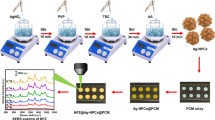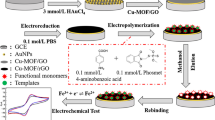Abstract
A highly sensitive 4-cyanophenol (4-CP) sensor was fabricated using multi-walled carbon nanotube (MWCNT)-embedded dual-microporous polypyrrole nanoparticle-modified screen-printed carbon electrodes (SPCE/DMPPy/MWCNT). The well-defined dual pores of DMPPy and MWCNT (~ 0.53 and ~ 0.65 nm) acted as good analyte absorption agents (shortening the ion diffusion path) and conducting agents (reducing the internal electron-transfer resistance). This enhanced electrical conductivity resulted in the improved electro-oxidation of 4-CP. A higher sensitivity (19.0 μA μM−1 cm−2) and lower limit of detection (0.8 nM) were achieved with a wide detection range of 0.001–400 µM (R2 = 0.9988). The proposed sensor exhibited excellent recovery of 4-CP in real-world samples. Therefore, the SPCE/DMPPy/MWCNT sensor is regarded highly suitable for rapidly detecting 4-CP.
Graphical Abstract







Similar content being viewed by others
Data availability
No data was used for the research described in the article.
References
Adamska G, Dabrowski R, Dziabuszek J (1981) Convenient method of obtaining 2-cyano-4-alkylphenols, 4-cyanophenol and 4-cyanoaniline. Mol Cryst Liq Cryst 76:93–99. https://doi.org/10.1080/00268948108074677
Gopi PK, Srinithi S, Chen SM, Ravikumar CH (2022) Designing of cerium-doped bismuth vanadate nanorods/functionalized-MWCNT nanocomposite for the high toxicity of 4-cyanophenol herbicide detection in human urine sample. Colloids Surfaces A Physicochem Eng Asp 639:128371. https://doi.org/10.1016/j.colsurfa.2022.128371
Fukuto TR, Metcalf RL (1956) Pesticidal activity and structure, structure and insecticidal activity of some diethyl substituted phenyl phosphates. J Agric Food Chem 4:930–935. https://doi.org/10.1021/jf60069a001
Medendorp J, Yedluri J, Hammell DC et al (2006) Near-infrared spectrometry for the quantification of dermal absorption of econazole nitrate and 4-cyanophenol. Pharm Res 23:835–843. https://doi.org/10.1007/s11095-006-9749-z
Bronner C, Wenger OS (2012) Proton-coupled electron transfer between 4-cyanophenol and photoexcited rhenium(I) Complexes with different protonatable sites. Inorg Chem 51:8275–8283. https://doi.org/10.1021/ic300834c
Dimitrova Y, Tsenov JA (2007) Theoretical study of the structures and vibrational spectra of the hydrogen-bonded systems of 4-cyanophenol with N-bases. Spectrochim Acta Part A Mol Biomol Spectrosc 68:454–459. https://doi.org/10.1016/j.saa.2006.11.050
Hwa K-Y, Ganguly A, Tata SKS (2020) Influence of temperature variation on spinel-structure MgFe2O4 anchored on reduced graphene oxide for electrochemical detection of 4-cyanophenol. Microchim Acta 187:633. https://doi.org/10.1007/s00604-020-04613-z
Hamai S, Satoh N (1997) Inclusion effects of cyclomaltohexa- and heptaose (α- and β-cyclodextrins) on the acidities of several phenol derivatives. Carbohydr Res 304:229–237. https://doi.org/10.1016/S0008-6215(97)00279-6
Jesila JA, Umesh NM, Wang S-F et al (2021) An electrochemical sensing of phenolic derivative 4-cyanophenol in environmental water using a facile-constructed Aurivillius-structured Bi2MoO6. Ecotoxicol Environ Saf 208:111701. https://doi.org/10.1016/j.ecoenv.2020.111701
Rahman MM, Alfaifi SY (2021) Fabrication of novel and potential selective 4-cyanophenol chemical sensor probe based on Cu-doped Gd2O3 nanofiber materials modified PEDOT:PSS polymer mixtures with Au/µ-Chip for effective monitoring of environmental contaminants from various water sampl. Polymers (Basel) 13:3379. https://doi.org/10.3390/polym13193379
Sekhosana KE, Shumba M, Nyokong T (2019) Electrochemical detection of 4-chlorophenol using glassy carbon electrodes modified with thulium double-decker phthalocyanine salts. ChemistrySelect 4:8434–8443. https://doi.org/10.1002/slct.201803891
Wu D, Xu F, Sun B et al (2012) Design and preparation of porous polymers. Chem Rev 112:3959–4015. https://doi.org/10.1021/cr200440z
Paik P, Gedanken A, Mastai Y (2010) Chiral-mesoporous-polypyrrole nanoparticles: Its chiral recognition abilities and use in enantioselective separation. J Mater Chem 20:4085. https://doi.org/10.1039/c000232a
Rawal I, Kaur A (2013) Synthesis of mesoporous polypyrrole nanowires/nanoparticles for ammonia gas sensing application. Sensors Actuators A Phys 203:92–102. https://doi.org/10.1016/j.sna.2013.08.023
Qin J, Gao J, Shi X et al (2020) Hierarchical ordered dual-mesoporous polypyrrole/graphene nanosheets as bi-functional active materials for high-performance planar integrated system of micro-supercapacitor and gas sensor. Adv Funct Mater 30:1909756. https://doi.org/10.1002/adfm.201909756
Liu S, Wang F, Dong R et al (2016) Dual-template synthesis of 2D mesoporous polypyrrole nanosheets with controlled pore size. Adv Mater 28:8365–8370. https://doi.org/10.1002/adma.201603036
Park H, Kim JW, Hong SY et al (2018) Microporous polypyrrole-coated graphene foam for high-performance multifunctional sensors and flexible supercapacitors. Adv Funct Mater 28:1707013. https://doi.org/10.1002/adfm.201707013
Rajkumar C, Kim H (2022) An amperometric electrochemical sensor based on hierarchical dual- microporous structure polypyrrole nanoparticles for determination of pyrogallol in the aquatic environmental samples. Microchem J 183:108038. https://doi.org/10.1016/j.microc.2022.108038
Sun C-L, Chang C-T, Lee H-H et al (2011) Microwave-Assisted Synthesis of a Core-Shell MWCNT/GONR Heterostructure for the Electrochemical Detection of Ascorbic Acid, Dopamine, and Uric Acid. ACS Nano 5:7788–7795. https://doi.org/10.1021/nn2015908
Gao Y, Wang M, Yang X, Sun Q, Zhao J et al (2014) Rapid detection of quinoline yellow in soft drinks using polypyrrole/single-walled carbon nanotubes composites modified glass carbon electrode. J Electroanal Chem 735:84–89. https://doi.org/10.1016/j.jelechem.2014.10.011
Sulak M-T, Erhan E, Keskinler B et al (2012) Electrochemical phenol biosensor configurations based on nanobiocomposites. Sens Mater 24(3):141–152
Bourigua S, Errachid A, Dzyadevych S et al (2011) Impedimetric urea biosensor based on single-wall carbon nanotubes (SWCNT-COOH) and polypyrrole. Sens Lett 9(6):2232–2235. https://doi.org/10.1166/sl.2011.1768
Cho B, Lim H, Lee H-N et al (2021) High-capacity and cycling-stable polypyrrole-coated MWCNT@polyimide core-shell nanowire anode for aqueous rechargeable sodium-ion battery. Surf Coatings Technol 407:126797. https://doi.org/10.1016/j.surfcoat.2020.126797
ParayangattilJyothibasu J, Chen M-Z, Lee R-H (2020) Polypyrrole/carbon nanotube freestanding electrode with excellent electrochemical properties for high-performance all-solid-state supercapacitors. ACS Omega 5:6441–6451. https://doi.org/10.1021/acsomega.9b04029
Alcaraz-Espinoza JJ, de Melo CP, de Oliveira HP (2017) Fabrication of highly flexible hierarchical polypyrrole/carbon nanotube on eggshell membranes for supercapacitors. ACS Omega 2:2866–2877. https://doi.org/10.1021/acsomega.7b00329
Ramesh S, Haldorai Y, Kim HS, Kim J-H (2017) A nanocrystalline Co 3 O 4 @polypyrrole/MWCNT hybrid nanocomposite for high performance electrochemical supercapacitors. RSC Adv 7:36833–36843. https://doi.org/10.1039/C7RA06093A
Bello RH, Coelho LA, Becker D (2018) Role of chemical funcionalization of carbon nanoparticles in epoxy matrices. J Compos Mater 52:449–464. https://doi.org/10.1177/0021998317709082
Laschuk NO, Easton EB, Zenkina OV (2021) Reducing the resistance for the use of electrochemical impedance spectroscopy analysis in materials chemistry. RSC Adv 11:27925–27936. https://doi.org/10.1039/D1RA03785D
Manikandan R, Raj CJ, Rajesh M et al (2018) Electrochemical behaviour of lithium, sodium and potassium ion electrolytes in a Na 0.33 V 2 O 5 symmetric pseudocapacitor with high performance and high cyclic stability. ChemElectroChem 5:101–111. https://doi.org/10.1002/celc.201700923
Stejskal J (2020) Interaction of conducting polymers, polyaniline and polypyrrole, with organic dyes: polymer morphology control, dye adsorption and photocatalytic decomposition. Chem Pap 74:1–54. https://doi.org/10.1007/s11696-019-00982-9
Majumdar S, Nath J, Mahanta D (2018) Surface modified polypyrrole for the efficient removal of phenolic compounds from aqueous medium. J Environ Chem Eng 6:2588–2596. https://doi.org/10.1016/j.jece.2018.04.002
Laviron E (1979) General expression of the linear potential sweep voltammogram in the case of diffusionless electrochemical systems. J Electroanal Chem Interfacial Electrochem 101:19–28. https://doi.org/10.1016/S0022-0728(79)80075-3
Forryan CL, Lawrence NS, Rees NV, Compton RG (2004) Voltammetric characterisation of the radical anions of 4-nitrophenol, 2-cyanophenol and 4-cyanophenol in N, N-dimethylformamide electrogenerated at gold electrodes. J Electroanal Chem 561:53–65. https://doi.org/10.1016/j.jelechem.2003.07.001
Acknowledgements
This study was supported by a National Research Foundation of Korea (NRF) grant funded by the Korean government (MSIT; No. 2019R1A5A808029011).
Author information
Authors and Affiliations
Contributions
Chellakannu Rajkumar: Conceptualization, Methodology, Validation, Investigation, Writing—Original Draft. Haekyoung Kim: Validation, Writing—Review & Editing, Resources, Supervision, Funding acquisition, Project administration.
Corresponding author
Ethics declarations
Competing interests
The authors declare no known competing interests.
Additional information
Publisher's note
Springer Nature remains neutral with regard to jurisdictional claims in published maps and institutional affiliations.
Supplementary Information
Below is the link to the electronic supplementary material.
Rights and permissions
Springer Nature or its licensor (e.g. a society or other partner) holds exclusive rights to this article under a publishing agreement with the author(s) or other rightsholder(s); author self-archiving of the accepted manuscript version of this article is solely governed by the terms of such publishing agreement and applicable law.
About this article
Cite this article
Rajkumar, C., Kim, H. 4-Cyanophenol herbicide sensor using multi-walled carbon nanotube embedded dual-microporous polypyrrole nanoparticles as metal-free and environmentally friendly hybrid electrode. Microchim Acta 190, 197 (2023). https://doi.org/10.1007/s00604-023-05773-4
Received:
Accepted:
Published:
DOI: https://doi.org/10.1007/s00604-023-05773-4




